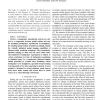Free Online Productivity Tools
i2Speak
i2Symbol
i2OCR
iTex2Img
iWeb2Print
iWeb2Shot
i2Type
iPdf2Split
iPdf2Merge
i2Bopomofo
i2Arabic
i2Style
i2Image
i2PDF
iLatex2Rtf
Sci2ools
TASLP
2008
2008
Phantom Materialization: A Novel Method to Enhance Stereo Audio Reproduction on Headphones
Abstract-- Loudspeaker reproduction systems are subject to a compromise between spatial realism and cost. By simulating loudspeaker reproduction on headphones, the resulting spatial realism is limited accordingly, despite the virtually unlimited spatial imaging capabilities of binaural audio rendering technology. More particularly, phantom imaging as often used for stereo audio material intended for loudspeaker reproduction is subject to various restrictions in terms of loudspeaker positioning in simulated space. As a consequence, phantom imaging should preferably be avoided when simulating virtual loudspeakers over headphones, especially if head tracking is incorporated or if a wide sound stage is desired. A novel method is described to extract phantom sound sources from stereo audio content and convert these to sound sources in a virtual listening environment.
| Added | 15 Dec 2010 |
| Updated | 15 Dec 2010 |
| Type | Journal |
| Year | 2008 |
| Where | TASLP |
| Authors | Jeroen Breebaart, Erik Schuijers |
Comments (0)

